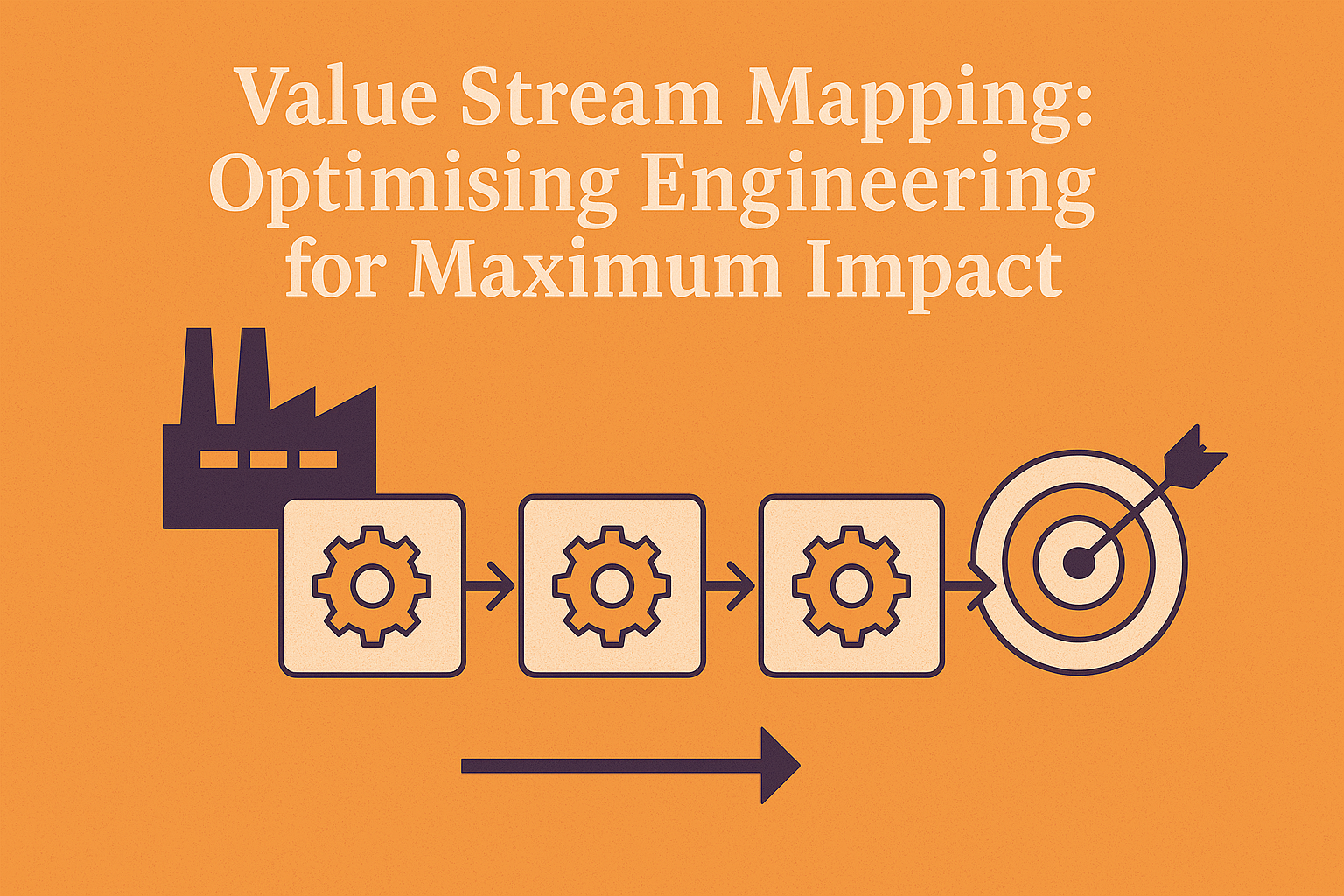Value Stream Mapping: Optimising Engineering for Maximum Impact

In the relentless pace of digital delivery, engineering teams are under constant pressure to move faster, scale smarter, and do more with less. But velocity alone isn’t enough - speed without direction leads to waste, rework, and missed opportunities.
To truly optimise engineering for impact, we must understand where value is created - and where it’s lost. This is where Value Stream Mapping (VSM) comes in.
VSM is more than a lean technique or a visual exercise. It’s a strategic lens that helps engineering organisations see the whole system - across people, process, tools, and flow. It surfaces friction, bottlenecks, and misalignment, allowing teams to focus on what matters most: delivering value to customers, faster and more reliably.
What is Value Stream Mapping?
A value stream is the end-to-end sequence of activities required to deliver a product or feature - from idea to deployment and beyond. Value Stream Mapping is the process of visualising this flow to identify delays, inefficiencies, and waste.
In digital engineering, this means mapping everything from:
Idea generation and backlog refinement
Design and architecture decisions
Development, testing, and code review
CI/CD pipeline stages
Release, deployment, and operations
Feedback, monitoring, and iteration
By making work visible, VSM helps teams shift from siloed optimisation to system-level thinking - where improving the whole is more important than speeding up individual parts.
Why Engineering Teams Should Care About VSM
Engineering is often optimised around output - how many features are shipped, how many story points delivered. But without understanding flow, those metrics can be misleading.
Here’s how Value Stream Mapping helps unlock greater impact:
✅ Expose Hidden Bottlenecks
Many delays in engineering aren’t caused by technical complexity - they stem from handoffs, unclear requirements, review wait times, or overloaded processes. VSM makes these visible, so they can be addressed directly.
✅ Reduce Waste and Context Switching
Mapping the flow of value helps identify unnecessary rework, duplicated effort, and multitasking that burns time without delivering value.
✅ Align Technical Work to Business Outcomes
VSM connects engineering activity to real-world outcomes. It creates shared understanding between developers, product, and stakeholders - so everyone is working toward the same definition of success.
✅ Accelerate Feedback Loops
By visualising where feedback is delayed - between coding and testing, deployment and monitoring, or user feedback and iteration - teams can design for faster learning and quicker course correction.
✅ Foster Cross-Functional Collaboration
Value doesn’t flow within teams - it flows across them. VSM helps break down silos by focusing everyone on improving the flow of work, not just individual performance.
How to Run an Effective Value Stream Mapping Session
Implementing VSM doesn’t need to be a heavyweight process. Here's how to get started:
1. Define the Value Stream Scope
Start by choosing a specific flow to map - such as delivering a new feature, responding to an incident, or onboarding a new customer.
2. Bring Together the Whole System
Include participants from across the value stream: developers, product managers, testers, UX designers, DevOps, and security. Everyone who contributes to the process should be part of the conversation.
3. Map the Current State
Document the steps from concept to delivery, including:
What happens at each stage?
Who is responsible?
How long does each step take?
Where are the delays or rework loops?
Use sticky notes or digital tools to visualise it - what matters is making the work visible.
4. Identify Waste and Friction
Look for:
Handoffs and approvals that slow progress
Long wait times (e.g., code reviews, test environments)
Manual steps that could be automated
Loops where work returns upstream due to unclear requirements or defects
5. Design the Future State
Ask: how could we improve flow and reduce lead time? This might include:
Automating slow processes
Reducing WIP (work in progress)
Improving requirements definition
Clarifying ownership
Empowering teams to make more local decisions
6. Prioritise and Act
Identify a few high-leverage changes to pilot. Don’t try to fix everything at once. Focus on experiments that reduce cycle time, improve quality, or enhance feedback.
Example: VSM in Practice
A software team mapped their feature delivery process and discovered that code sat in review queues for an average of three days - more than the time it took to write the code itself.
By adjusting working agreements, setting SLAs on review time, and pairing on critical changes, they cut review delay by 70% - resulting in faster delivery and higher team satisfaction.
This kind of improvement doesn’t come from writing code faster - it comes from understanding the flow of value and reducing friction in the system.
Key Takeaways
✅ Value Stream Mapping gives teams visibility into where value is created - and where it’s lost.
✅ It helps engineering shift from local optimisation to system-wide impact.
✅ The goal is faster, more reliable delivery of customer value - not just more code.
✅ VSM aligns teams, surfaces hidden waste, and enables meaningful improvement.
✅ Every engineering leader should be able to answer: “Where does value get stuck in our system?”
Final Word
In digital engineering, speed and quality aren't achieved by working harder - they’re achieved by working smarter. That means looking beyond code and tasks, and focusing on flow.
Value Stream Mapping isn’t just a lean tool - it’s a strategic capability. It brings engineering closer to the business, connects effort to impact, and creates the conditions for continuous, scalable delivery of real value.
Because in the end, it's not about how fast you go - it's about how far your impact reaches. And VSM helps ensure every sprint, story, and deployment is moving you in the right direction.
Engineering leader blending strategy, culture, and craft to build high-performing teams and future-ready platforms. I drive transformation through autonomy, continuous improvement, and data-driven excellence - creating environments where people thrive, innovation flourishes, and outcomes matter. Passionate about empowering others and reshaping engineering for impact at scale. Let’s build better, together.
